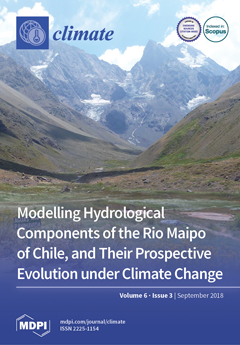We used the
Poly-Hydro model to assess the main hydrological components of the snow-ice melt driven Maipo River in Chile, and glaciers’ retreat under climate change therein until 2100. We used field data of ice ablation, ice thickness, weather and hydrological data, and precipitation from TRMM. Snow cover and temperature were taken from MODIS. We forced the model using weather projections until 2100 from three GCMs from the IPCC AR5, under three different radiative concentration pathways (RCPs 2.6, 4.5, 8.5). We investigated trends of precipitation, temperature, and hydrology until 2100 in the projection period (PR, 2014–2100) and the whole period (CM 1980–2100, composite), against historical trends in control period (CP, 1980–2013). We found potentially increasing temperature until 2100, except for Spring (OND). In the PR period, yearly flow decreases significantly under RCP85, on average −0.25 m
3·s
−1·year
−1, and down to −0.48 m
3·s
−1·year
−1, i.e., −0.4% year
−1 against CP yearly average (120 m
3 s
−1). In the long run (CM) significant flow decrease would, occur under almost all scenarios, confirming persistence of a historical decrease, down to −0.39 m
3·s
−1·year
−1 during CM. Large flow decreases are expected under all scenarios in Summer (JFM) during PR, down to −1.6 m
3·s
−1·year
−1, or −1% year
−1 against CP for RCP8.5, due to increase of evapotranspiration in response to higher temperatures. Fall (AMJ) flows would be mostly unchanged, while Winter (JAS) flows would be projected to increase significantly, up to 0.7 m
3·s
−1·year
−1 during 2014–2100, i.e., +0.9% year
−1 vs. CP under RCP8.5, due to large melting therein. Spring (OND) flows would decrease largely under RCP8.5, down to −0.67 m
3 s
−1·year
−1, or −0.4% year
−1 vs. CP, again due to evapotranspiration. Glacier down wasting is projected to speed up, and increasingly so with RCPs. Until 2100 ice loss would range from −13% to −49% (−9%, and −39% at 2050) of the estimated volume at 2012, which changed by −24% to −56% (−21%, and −39% at 2050) vs. ice volume in 1982, thus with rapider depletion in the first half of the century. Policy makers will have to cope with modified hydrological cycle in the Maipo River, and greatly decreasing ice cover in the area.
Full article





